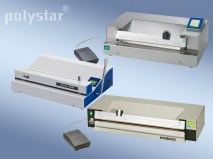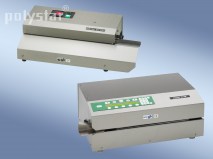Securely sealing medical packaging with polystar® film sealers
As in the industrial sector, there is a wide variety of packaging in the medical field: Primary, secondary and tertiary packaging have very different tasks, all of which must be executed flawlessly. The films used for these tasks are just as diverse. And, preferably, all types of film – in bag or tube film form – should be sealed using the same film sealer.
Medical table-top sealers by polystar® with an extra-wide sealing seam
It goes without saying that anyone who wants to seal medical packaging correctly has to abide by a large number of regulations. This is particularly true if the packaged product is then supposed to go to the autoclave for sterilisation. Generally, a packaging process that complies with the standards DIN EN 868 Packaging for terminally sterilized medical devices and DIN 58953 Sterilization – Sterile supply has to be chosen for this.
One specification from the above-mentioned standards is a sealing seam width of at least 6 mm. All our medical film sealers comfortably meet this requirement, because we add at least another 2 mm: all medical table-top sealers from polystar® produce a sealing seam width of at least 8 mm. However, there are some film sealers with a sealing seam width of 15 mm (with corrugation).
Another very important specification in medical technology is validation standard DIN EN ISO 11607. We also offer medical table-top sealers that comply with this very broad standard.
polystar® film sealers made of stainless steel for an easy clean
If you have to make sure that your products, e.g. instruments or prosthetics, etc., can be securely packed ready for sterilisation, then the tools needed for this – in this case the medical film sealers – have to be easy to clean/disinfect. For this reason, all medical table-top sealers by polystar® come in a stainless steel housing. Really? All of them? No... actually, there is one film sealer – specially designed for dental applications – that comes with paintwork compatible with disinfectants, just to add a touch of colour.
But, whether stainless steel or paint, the medical film sealers are delightfully easy to clean using a soft, slightly damp cloth.
polystar® film-sealing techniques
Let’s now talk about the different film-sealing techniques. With the medical table-top sealers, there are two different types of sealing method.
On the one hand, there is the classic thermal impulse sealing method. The film sealers that use this technique are ready for immediate use without a warm-up phase. The impulse for the sealing is triggered either by hand or by foot. The preset parameters are “worked through” automatically one after the other and the packaging is expertly sealed. It can then proceed directly to sterilisation. The thermal impulse sealing method is suitable both for bags and for tube films.
On the other hand, there is the fast continuous rotary heat sealing method. These film sealers have to be heated to the preset temperature before work can begin. Depending on the parameters set, this may take five to ten minutes. Afterwards, the temperature is kept constant so that you can seal your bags one after the other without having to slow down. This method is not suitable for tube films.
We provide both methods for “conventional” applications and for applications requiring validation as per DIN EN ISO 11607.
Wide variety of usage options for polystar® film sealers
No matter where you have to seal films – in the doctor’s surgery, dental laboratory, diagnosis room, sterilisation department of the hospital, etc...
No matter whether your packaging is a bag or tube film...
No matter whether your packaged products are then sterilised in an autoclave...
And no matter whether or not you have to adhere to the validation standard...
...polystar® is guaranteed to have the right film sealer for you!
By the way...
...we also have suitable sterilisation films in bag form or as tube films, with or without a gusset.
Just have a browse on our homepage in the “Foils/Sterilization packaging material” section.





